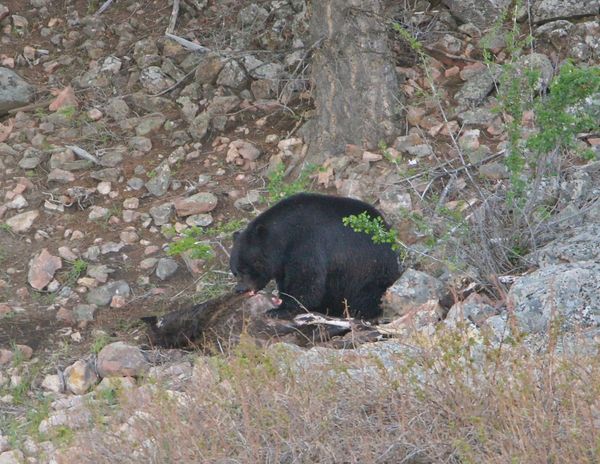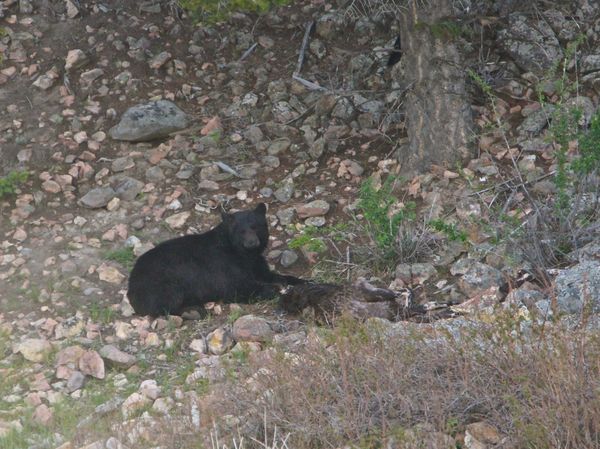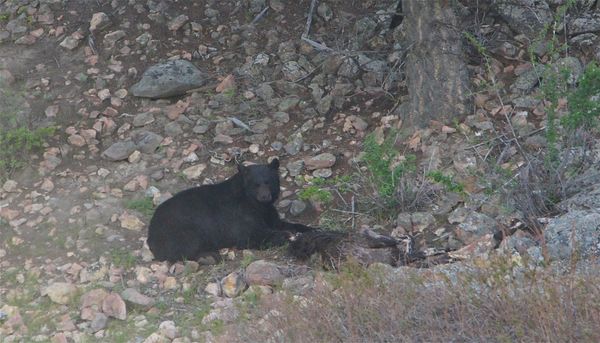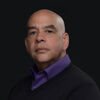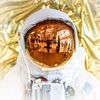Photographing a dark looking subject - need advice
Jun 15, 2015 10:39:22 #
We came across a very dark black bear at Yellowstone. It was about 7ish in the evening so the light was changing. I futzed with shutter speed at iso 1600 (1/320, 1/400, 1/500) at f6.3. A lower iso was too dark on my exposure and lcd screen so I only saved the iso1600 photos. To me the bear looks noisy. I think I still underexposed the bear and had to lift shadows out of it during post. How does one get a good photo of a dark subject like this bear when the surrounding environment is lighter?? I consider myself a rank amateur so please be gentle!!! Thanks
Jun 15, 2015 10:47:14 #
Quick question: How close were you? Has nothing to do with the exposure, just wondering.
Jun 15, 2015 11:05:02 #
You will receive many suggestions as each of us has our own favorite way :)
I would have used shutter priority since the bear was moving. As it probably wasn't moving fast, probably no more than 1/500 sec as you did.
I would have then set exposure compensation to + 2/3 or maybe even +1. This would have lightened the whole scene, giving me more detail in the bear.
Because of overall darkness, the ISO (which I often leave in auto) would have been high, but that would be unavoidable given the conditions. It's also likely, with my cameras anyway (Canon T3i, Canon SX50) that focus would have been problematic given the relative lack of contrast between the subject and background.
I think you did well, and these could possibly be edited further to bring out more detail.
I would have used shutter priority since the bear was moving. As it probably wasn't moving fast, probably no more than 1/500 sec as you did.
I would have then set exposure compensation to + 2/3 or maybe even +1. This would have lightened the whole scene, giving me more detail in the bear.
Because of overall darkness, the ISO (which I often leave in auto) would have been high, but that would be unavoidable given the conditions. It's also likely, with my cameras anyway (Canon T3i, Canon SX50) that focus would have been problematic given the relative lack of contrast between the subject and background.
I think you did well, and these could possibly be edited further to bring out more detail.
Jun 15, 2015 11:09:54 #
Jun 15, 2015 11:37:35 #
Linda From Maine wrote:
You will receive many suggestions as each of us ha... (show quote)
I'm with Linda.... Assuming your lens aperture was not able to go larger than the setting you used. Would have been nice to have an f1.8 or better..... Again if you are close enough because if you were a long throw then you would have to crop so closely and have a new problem. If you shot in raw then there is probably still editing you can do. Wonderful captures and do you know what he is eating?
BTW also taking your reading for the shot while focused on the lighter background sometimes helps to bring out the darker subject!
From one rank amateur to another..... Michael
Jun 15, 2015 11:42:53 #
Jun 15, 2015 11:54:31 #
wapusk wrote:
We came across a very dark black bear at Yellowsto... (show quote)
You are asking a couple questions together, but I'll answer the exposure one. I would use spot metering with my exposure comp possibly at -2/3.
Remember, your camera's metering system will try to overexpose dark objects and underexpose bright objects to achieve 18% grey. This is why you'll hear people increasing their exposure comp when shooting snow, and lowering their exposure comp when shooting something black. It sounds backwards at first, but once you get comfortable with how your camera exposes, it will become second nature to you. Hope this helps.
Jun 15, 2015 12:33:43 #
We were about 150 yards away...far enough that even I could get into the car!
Jun 15, 2015 12:35:04 #
Sorry Karl. I was using my Sony a500 with a Tamron 150-600mm lens.
Jun 15, 2015 12:36:44 #
Thank you Linda. I really need to practice/understand exposure metering so that it becomes intuitive to me.
Jun 15, 2015 12:37:24 #
mdorn wrote:
You are asking a couple questions together, but I'll answer the exposure one. I would use spot metering with my exposure comp possibly at -2/3.
This brings up a good point about metering. I had suggested going to the + side on exposure compensation because I was assuming a meter reading of the entire scene. So a discussion of the metering mode is a good idea too!
A neat video that Angela K found will explain all:
http://youtu.be/99MnkyzW3IY
Jun 15, 2015 12:41:01 #
Thank you Michael. I believe he was eating an elk. When we drove by the spot at 6ish there was no activity. Going back about an hour later gave us the action so it happened fast. We met up with a biologist the next morn and he thought the elk may have been calving so vulnerable to attack. The funny thing was that a park ranger was telling people the bear pulled a bison carcass out of the lake...like the Disney version of what happened :)
Jun 15, 2015 12:42:10 #
wapusk wrote:
We came across a very dark black bear at Yellowsto... (show quote)
It doesn't matter what color your subject or back ground are if the subject and the background are in the same light. (they seem like they are)
I know folks will fill this thread with endless recommendations on how to second guess what the meter is doing or how to fix bad exposures but I go about things differently.
If this were me. I always "pre-set" my camera's exposure for the conditions I'm in or will shortly be in. I shoot manually which only means that my camera is set on a particular ISO, shutter speed, and aperture.
That way I'm not surprised when I push the shutter button...I know what the exposure will be.
I use a hand held incident meter if the shot is something that I'm going to get serious about, but USUALLY I will pre meter off of the palm of my hand or green grass or a grey card, and then set the camera accordingly.
A dark or light subject on a dark or light background only matters when you are using the in camera meter because it uses reflected light and different tones reflect different amounts of light.
If you were a long distance off and you weren't in the same light as the bear, then what I said above won't be applicable.
If that's the case, then I'd use mult-metering mode and take a shot, and then bracket exposure up one and down one to make sure I get the correct one.
Jun 15, 2015 12:42:21 #
OK modern...what is my second question??? Know I am really showing my naïveté
Jun 15, 2015 12:51:03 #
wapusk wrote:
Thank you Michael. I believe he was eating an elk. When we drove by the spot at 6ish there was no activity. Going back about an hour later gave us the action so it happened fast. We met up with a biologist the next morn and he thought the elk may have been calving so vulnerable to attack. The funny thing was that a park ranger was telling people the bear pulled a bison carcass out of the lake...like the Disney version of what happened :)
Ha! Interesting story line for the ranger to take.
If you want to reply, then register here. Registration is free and your account is created instantly, so you can post right away.

